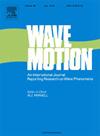Persistence of integrable wave dynamics in the Discrete Gross–Pitaevskii equation: The focusing case
IF 2.5
3区 物理与天体物理
Q2 ACOUSTICS
引用次数: 0
Abstract
Expanding upon our prior findings on the proximity of dynamics between integrable and non-integrable systems within the framework of nonlinear Schrödinger equations, we examine this phenomenon for the focusing Discrete Gross–Pitaevskii equation in comparison to the Ablowitz–Ladik lattice. The presence of the harmonic trap necessitates the study of the Ablowitz–Ladik lattice in weighted spaces. We establish estimates for the distance between solutions in the suitable metric, providing a comprehensive description of the potential evolution of this distance for general initial data. These results apply to a broad class of nonlinear Schrödinger models, including both discrete and partial differential equations. For the Discrete Gross–Pitaevskii equation, they guarantee the long-term persistence of small-amplitude bright solitons, driven by the analytical solution of the AL lattice, especially in the presence of a weak harmonic trap. Numerical simulations confirm the theoretical predictions about the proximity of dynamics between the systems over long times. They also reveal that the soliton exhibits remarkable robustness, even as the effects of the weak harmonic trap become increasingly significant, leading to the soliton’s curved orbit.
离散Gross-Pitaevskii方程中可积波动动力学的持续性:重点案例
在我们之前关于非线性Schrödinger方程框架内可积和不可积系统之间动力学接近性的发现的基础上,我们研究了与Ablowitz-Ladik晶格相比,聚焦离散Gross-Pitaevskii方程的这种现象。谐波阱的存在要求对加权空间中的Ablowitz-Ladik晶格进行研究。我们在合适的度量中建立了解之间距离的估计,为一般初始数据提供了该距离潜在演变的全面描述。这些结果适用于广义的非线性Schrödinger模型,包括离散和偏微分方程。对于离散Gross-Pitaevskii方程,他们保证了由AL晶格的解析解驱动的小振幅亮孤子的长期持久性,特别是在弱谐波陷阱存在的情况下。数值模拟证实了理论预测,即在长时间内系统之间的动力学接近。他们还揭示,即使弱谐波阱的影响变得越来越显著,导致孤子的弯曲轨道,孤子也表现出显著的稳健性。
本文章由计算机程序翻译,如有差异,请以英文原文为准。
求助全文
约1分钟内获得全文
求助全文
来源期刊

Wave Motion
物理-力学
CiteScore
4.10
自引率
8.30%
发文量
118
审稿时长
3 months
期刊介绍:
Wave Motion is devoted to the cross fertilization of ideas, and to stimulating interaction between workers in various research areas in which wave propagation phenomena play a dominant role. The description and analysis of wave propagation phenomena provides a unifying thread connecting diverse areas of engineering and the physical sciences such as acoustics, optics, geophysics, seismology, electromagnetic theory, solid and fluid mechanics.
The journal publishes papers on analytical, numerical and experimental methods. Papers that address fundamentally new topics in wave phenomena or develop wave propagation methods for solving direct and inverse problems are of interest to the journal.
 求助内容:
求助内容: 应助结果提醒方式:
应助结果提醒方式:


